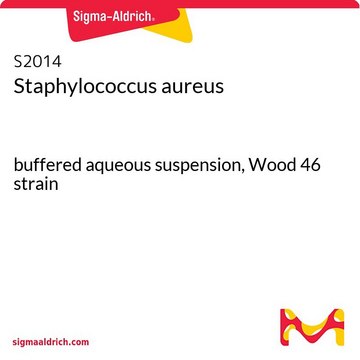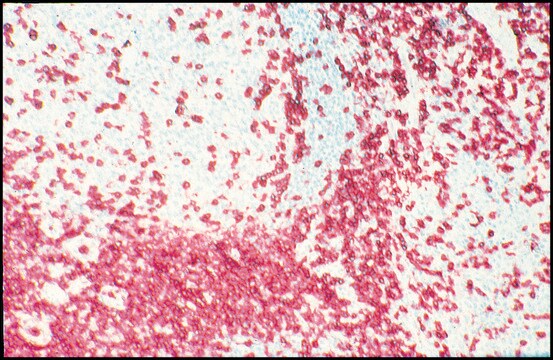S7531
Anti-Staphylococcal α-Toxin antibody produced in rabbit
whole antiserum
Synonym(s):
Anti-α-Hemolysin
Sign Into View Organizational & Contract Pricing
All Photos(1)
About This Item
Recommended Products
biological source
rabbit
Quality Level
conjugate
unconjugated
antibody form
whole antiserum
antibody product type
primary antibodies
clone
polyclonal
mol wt
antigen 33 kDa
contains
15 mM sodium azide
species reactivity
Staphylococcus aureus
packaging
antibody small pack of 25 μL
technique(s)
dot blot: 1:20,000
indirect ELISA: 1:50,000
shipped in
dry ice
storage temp.
−20°C
target post-translational modification
unmodified
General description
Staphylococcal α toxin, a water soluble 33kD single polypeptide, is a cytotoxic agent secreted by Staphylococcus aureus. This protein has membrane damaging properties and accounts for erythrocyte lysis. Hence it is also referred to as lethal hemolytic toxin or α-hemolysin . Anti-staphylococcal α-toxin antibody can be used for studies of the toxin-membrane interaction. Rabbit anti-staphylococcal α-toxin antibody reacts specifically with staphylococcal α-toxin but not with staphylococcal enterotoxin A, cholera toxin or pseudomonas exotoxin A.
Immunogen
α-toxin (α-hemolysin) from Staphylococcus aureus
Application
Anti-staphylococcal α-toxin antibody can be used in indirect ELISA (1:50,000) and dot blot immunoassay (1: 20,000).
Applications in which this antibody has been used successfully, and the associated peer-reviewed papers, are given below.
Enzyme-linked immunosorbent assay (1 paper)
Enzyme-linked immunosorbent assay (1 paper)
Quality
The antiserum has been treated to remove lipoproteins.
Disclaimer
Unless otherwise stated in our catalog or other company documentation accompanying the product(s), our products are intended for research use only and are not to be used for any other purpose, which includes but is not limited to, unauthorized commercial uses, in vitro diagnostic uses, ex vivo or in vivo therapeutic uses or any type of consumption or application to humans or animals.
Not finding the right product?
Try our Product Selector Tool.
Storage Class Code
10 - Combustible liquids
WGK
nwg
Flash Point(F)
Not applicable
Flash Point(C)
Not applicable
Choose from one of the most recent versions:
Already Own This Product?
Find documentation for the products that you have recently purchased in the Document Library.
Alicia Lacoma et al.
Toxins, 13(2) (2021-02-11)
Staphylococcus aureus is a commensal and frequent colonizer of the upper respiratory tract. When mechanical ventilation disrupts natural defenses, S. aureus is frequently isolated from the lower airways, but distinguishing between colonization and infection is difficult. The objectives of this
Olivia A Todd et al.
mBio, 10(3) (2019-06-06)
Candida albicans and Staphylococcus aureus are among the most prevalent nosocomial pathogens that are responsible for severe morbidity and mortality, even with appropriate treatment. Using a murine model of polymicrobial intra-abdominal infection (IAI), we have previously shown that coinfection with
Shi-Jie Wan et al.
Frontiers in chemistry, 10, 877469-877469 (2022-04-19)
The emergence of antibiotic resistance in Staphylococcus aureus has necessitated the development of innovative anti-infective agents acting on novel targets. Alpha-hemolysin (Hla), a key virulence factor of S. aureus, is known to cause various cell damage and death. In this
Clarisse Leseigneur et al.
eLife, 11 (2022-06-21)
Nicotinamide adenine dinucleotide phosphate (NADPH) is the primary electron donor for reductive reactions that are essential for the biosynthesis of major cell components in all organisms. Nicotinamide adenine dinucleotide kinase (NADK) is the only enzyme that catalyzes the synthesis of
Ewa Olchowik-Grabarek et al.
Biochimica et biophysica acta. Biomembranes, 1864(10), 184011-184011 (2022-07-26)
Phenolic acids represent a class of drugs with mild antibacterial properties. We have synthesized iodinated gallic and ferulic acids and together with commercially available iodinated forms of salicylic acids studied their cytotoxicity, bacteriostatic and anti-virulence action. Out of these, iodogallic
Our team of scientists has experience in all areas of research including Life Science, Material Science, Chemical Synthesis, Chromatography, Analytical and many others.
Contact Technical Service







